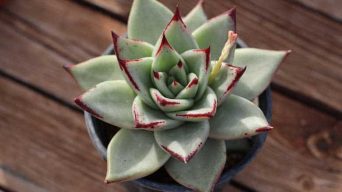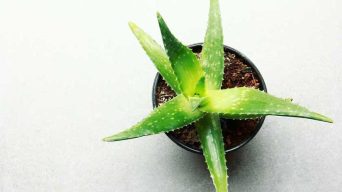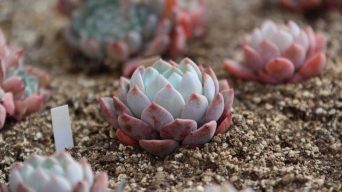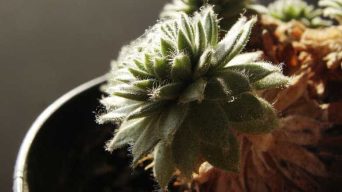Succulent plants are beautiful and require very little maintenance.
If you have a succulent plant that has grown too large to keep in your home, don’t worry!
It is possible to grow succulents from cuttings and create new plants for your home or garden.
The process is simple, but it can take some time before the new plant gets big enough for transplantation into its own pot.
This article will cover how to grow succulents from cuttings in detail and how to plant your succulent garden at home.
Best Types of Succulents to Grow from Cuttings
There are many types of succulents that you can grow from cuttings.
The best types of succulents to grow from cuttings are ones that will root quickly.
You can use many succulent plants for this purpose; however, some tend to be more successful than others.
For instance, succulents like Aeonium canariense, Haworthia truncata, Sedum nussbaumerianum, Crassula tetragona, and Euphorbia milii tend to be great for growing from cuttings.
Some succulents are challenging to grow from cuttings.
For instance, plants like the Echeveria species tend not to root well when grown from cuttings. It can take years for them to propagate correctly.
Another example of a plant that is tough to grow from cutting is Kalanchoe pumila.
The best way to determine how well a succulent will grow from cuttings is by trying it.
However, succulents can also grow from leaves. Try propagating it from leaves if you find a succulent that isn’t great for rooting cuttings.
How To Propagate Succulents From Cuttings
There are a handful of simple steps you need to take if you want to propagate succulents from cuttings.
To propagate succulents from cuttings, the main steps are:
- Take a cutting from the mother plant
- Let it callus over for a few days
- Root it in a succulent or cacti mix
- Transplant it when the new root system is well established
1. How To Take Cuttings From Succulents
Succulents are plants that retain water in their leaves or stems, allowing them to survive harsh drought conditions.
Succulent plants include cacti and desert varieties like jade plants. Still, you can grow succulents indoors even if they don’t come from dry climates.
When taking cuttings to grow succulents, look for cuttings with at least two to three joints or leaf nodes. The stem should be firm, and the leaves healthy-looking with no signs of mold or rot.
Before taking your succulent cutting, wash your hands in soap and water, so you don’t spread any diseases from one plant to another.
First, remove the leaves at their base using sharp pruning shears or a razor blade to take cuttings from succulents.
Leave about an inch of stem below each leaf node. Cut below the node, not through it. Make your cuts with a clean diagonal cut to encourage water flow and healing of the stem.
You can also take cuttings directly from the main stem if growing a cactus. Make a diagonal cut at least two inches long and just below the node.
Best Time To Take Succulent Cuttings
You can take cuttings to propagate succulents at any time of year, but spring and summer are best to encourage root growth.
You can take succulent cuttings any time of day as long as the weather is warm and dry.
However, you’ll have the best results if you take your cuttings in the early morning or after several hours of dry weather.
2. How to Callus Succulent Cuttings
After taking your succulent cuttings, you need to callus them before planting. Callus tissue forms a protective seal over the cut end of your stem to prevent moisture loss and disease from entering the open wound.
To callus succulent cuttings, place them in a dry location with bright light but not direct sunlight for about a week. It is best to keep them in a room around 70 degrees Fahrenheit.
You can callus succulent cuttings indoors, but you’ll get the best results if you place your cutting outside during summer weather.
To tell if the cuttings are callused enough to plant, lightly touch them with your finger. If the cutting feels dry and hard, like tree bark, it’s ready for planting.
If not, continue leaving them in a warm location until they feel dry and firm to the touch before proceeding with the planting instructions below.
3. How to Root Succulent Cuttings
You have successfully callused your succulent cuttings, so now it’s time to plant them.
There are two ways to root succulent cuttings: in water or directly in the soil.
How to Root Succulent Cuttings in Soil
To grow succulent cuttings in soil, use a fast-draining potting mix with plenty of sand and perlite.
Moisten the soil until it feels evenly damp but not wet to the touch-a good time to water is after you have finished planting your cutting.
Fill a small container or seedling tray with the moistened soil mixture and press down lightly on top so there are no air pockets.
Insert your calloused succulent cutting into the center of the planted area at least an inch deep. Gently pat down around the base to secure it without pressing too hard onto its leaves (you don’t want them squished).
Add more moistened succulent potting mix around the surrounding areas if needed.
Keep the soil moist but not saturated for best results, and watch for signs of rot on your succulents.
If you see any mold developing, cut it away with clean pruning shears before watering again to prevent the disease from spreading throughout your plants.
Place your succulent in a warm location with bright light but no direct sunlight. The ideal location for growing succulent cuttings is outdoors in summer weather conditions.
After about a week, check your cutting for roots by gently tugging the stem at its base to see if it’s firmly anchored.
It should stay in the soil when you pull up. Only minimal growth should be noticeable after one month, depending on the succulent species.
If no new growth appears within two months, wait another month and water sparingly before testing again.
If you still don’t see any progress, try cutting the calluses around your stem cutting with a sharp pair of scissors. Look for signs of rot or fungi that might have started in the leaf nodes and spread to the roots.
Once no signs of rot are found, you can resume regular watering and wait another month to see if roots begin growing.
If your cutting shows no sign of new growth after two months, it’s time to try water propagation (see below) before giving up entirely on that particular plant species.
How to Root Succulent Cuttings in Water
If you grow your succulents in water, cut off all the leaves except for around two inches.
You can leave one leaf intact to prevent rot or mold growth, but ensure it’s not directly under the node.
Propagating succulent cuttings in water is best done indoors. You’ll have better control over humidity levels and temperature fluctuations that could lead to stem damage or disease.
Fill a small cup or glass with distilled water to root your cuttings in water. You can use tap water, but the chlorine and minerals could cause root damage over time, so it’s best to stick with distilled for cuttings.
Place your succulent cutting in the cup of water, leaving at least an inch between its base and the lip of the container to allow proper growth.
If you’re using multiple cuttings, leave two inches between each one.
Keep the water level at the base of your cutting low enough that it doesn’t touch the bottom leaves.
Place your cup with succulent cuttings under bright light but not direct sunlight.
The ideal location is where temperatures range around 65 degrees Fahrenheit during the day. Avoid window ledges or shelves close to heating vents if possible.
You can also use artificial lighting in cool climates to provide warmth and support root health when propagating succulents in water.
It’s best practice to change your cutting’s water every two weeks.
Removing dead leaves from the water as they fall off is also a good idea.
You should see roots form within the first few weeks. Once you see roots around two inches long, it’s time to transplant your succulents into the soil.
How Long Does It Take for Succulent Cuttings to Root?
Most succulents root within two weeks in the soil.
It takes around one month for the cutting to develop new growth if you’re rooting it in water. Still, many species can take up to six months or more before producing roots and leaves under standard conditions.
You can tell your succulent plant has rooted once you see new growth at its base, and it’s not loose or wobbly when tugged on. The roots should be firm and white.
4. How to Plant Succulent Cuttings
The final step for growing succulents from cuttings is transplanting your rooted cuttings into their permanent home when they’ve grown enough roots.
The most common way to plant succulents is in a container filled with succulent soil or cactus mix. However, succulents can also be planted on the ground or outdoors.
First, remove the succulent from its container and gently separate the roots.
Next, place your succulent in its new container. It should be approximately two inches bigger than where it was initially growing. Fill with potting soil or cactus mix until about an inch below the planter’s rim.
Use a spoon or your hands to pat the soil down around the plant’s roots, which should be about an inch below the soil line.
Once you’ve set the plant in place, fill around it with soil until all empty spaces have been filled.
It is important not to water it for at least a week after transplanting to reduce the risk of root rot.
What Is the Best Soil to Plant Succulents?
Succulents need a well-draining potting mix that will retain just enough water for them to grow correctly without getting soggy all the time.
A succulent or cactus soil mix is often used because it has the perfect air and water ratio.
It can retain quite a bit of moisture and drain well enough to allow for good aeration around the roots, which prevents root rot and encourages strong growth.
How to Care For Newly Propagated Succulents
Once you have your new propagated succulent plants, taking special care of them is essential until they become established.
Succulents need a lot of bright, indirect sunlight during the day.
Keep your cuttings out of direct sun for at least a few days after they’ve been transplanted into their new pots to prevent them from getting burned by too much heat or sun exposure in one go.
It’s also vital that you don’t overwater succulent plants, especially young ones.
You should only water your plants when the soil is dry.
How often you need to water your succulents depends on how hot they are and whether they’re getting direct sunlight.
During the hotter summer months, you should water succulents weekly. During the winter, you can water them once every two weeks.
Succulents are very hardy plants, but they still need to be cared for if you want them to thrive.
Caring for succulents is easy and fun, but it takes a little time to get results. However, once they’ve established, your hardy succulents will mainly look after themselves!
Final Thoughts
You can easily propagate succulent plants by taking advantage of their unique growing process.
Succulents will grow roots from their stem cuttings very quickly and easily, which is why they make such a great choice if you’re starting with gardening.
You can propagate most succulents by cutting their leaves or stems into small pieces and leaving them dry for a few weeks.
Once the cuttings have dried out, they can be stuck in some soil and will start growing new roots quickly!
Growing succulents from cuttings is a straightforward process, but it’s important to note that the results won’t always be 100% successful.
However, with patience and the proper methods, you’ll be able to grow plants from cuttings successfully every time.







